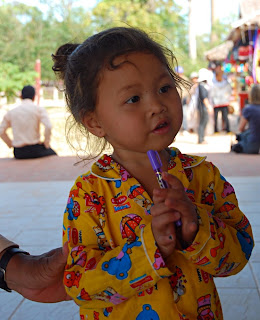 Welcome! This posting is dedicated to the children of Cambodia. I had many delightful moments taking photos of some that I met and saw, but it was distressing to see the poverty and the conditions in which many of them and their families live.
Welcome! This posting is dedicated to the children of Cambodia. I had many delightful moments taking photos of some that I met and saw, but it was distressing to see the poverty and the conditions in which many of them and their families live.You might feel the same when looking at some of the photos. But, often these little ones evoked wonder and joy at their capacity to be joyful, regardless. Bless them all
This young lady was determined to take possession
of my camera. She wasn't at all worried that
it is big and heavy, nor was she fazed by the tall
Caucasian male desperately trying to wrest it back!

The tug o' war carried on unabated until.......

.........she was persuaded to relinquish
her grip of steel in exchange for a pretty
coloured pen, which seemed to go
perfectly with her fabulous outfit.
My thanks to Daniela, my wife, for
taking these first two photos

This and the next 3 shots were taken at a floating
village on the Tonle Sap lake, near Siem Reap.
Children rush to have their photo taken, with
a snake, and then ask for money in exchange

Mum is close by. It is blatant
exploitation of their children,
but these people are fighting to
survive

A large bowl serves as a rudimentary craft,
which allows this young girl to get ahead
of the game..........

....and go to the tourists instead
of waiting for them to come to shore

Children playing in front of the Angkor Wat

Is she rushing to put some clothes on him?
One minute he was wearing them, the next
they were gone

On a street in Phnom Penh. Perhaps the
pedals don't work!

Sometimes a nap is needed to recuperate.
Hammocks are used widely by children
and adults in Cambodia. This one is attached
to a railing and a van parked on the street.
Look closely, the foot doesn't belong to
the little boy you can see. There are 2 hammocks

Even Mum has succumbed at a market in
Siem Reap

Takes my breath away!

Friends

Some have real tractors to play with!

Helping Mum and having fun

I took this shot from quite a distance and I was
in a boat. It speaks for itself

Taken in Phnom Penh by the Tonle Sap river
Both enjoying having their photos taken

This little girl on the other hand wasn't quite
so sure

Friends and a puppy at Banteay Srei Temple

In the country outside Siam Reap

The back seat doesn't look too comfortable!

Friends playing, but conscious of the camera

A leading fashion model

This fashion model needs a bit more practice
before taking to the catwalk

A very proud dad

The fashion in Siam Reap is..
.........original!

A final salute
Next time photos of Ta Promh, the temple
where scenes from the film "Tomb Raider" were shot
































